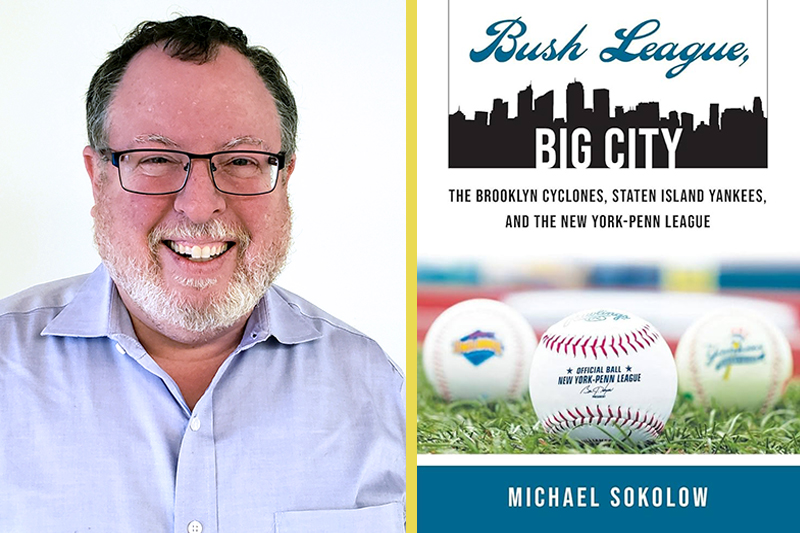KCC Ovations
Hitting a Home Run in Coney Island: New Book Tells the Untold Stories of NYC's Minor League Baseball

Michael Sokolow uncovers the hidden gems of NYC's minor league baseball history in his newest book, “Bush League, Big City: The Brooklyn Cyclones, Staten Island Yankees, and the New York-Penn League” (SUNY Press, April 2023).
While the two minor league baseball teams hit their stride in the early 2000s, the Cyclones and the "Baby Bombers" were destined for different fates: one soaring to astronomical heights, the other sinking under the weight of debt and misfortune.
This book goes beyond the games on the field. It's an eye-opening journey into the history of the New York-Penn League, America's oldest and longest-running minor league, dating back to its inception in 1939. Sokolow, a history professor at Kingsborough Community College, takes us on a roller-coaster ride through time, unveiling how minor league baseball transformed from local ownership and small-town roots to becoming big business under the watchful eye of Major League Baseball.
"Bush League, Big City" also exposes the behind-the-scenes influence of New York City politics, particularly during the era of Mayor Rudy Giuliani. Sokolow reveals how Giuliani's determination shaped not just the city's landscape but also the world of professional baseball. By the time he was done, New York City had committed itself to financing not two but six stadium projects for the Yankees and Mets organizations, all at taxpayer expense.
Sokolow takes readers through the intricacies of the locations and marketing efforts of creating Keyspan Park in Coney Island and Richmond County Bank Ballpark in Staten Island as well, shedding light on their influence on the teams' destinies. They weren't just bricks and mortar but symbols of a colossal $120 million municipal investment. The Cyclones struck marketing gold, situated in the heart of historic Coney Island, drawing fans with a wave of nostalgia. At the same time, the Staten Island Yankees faced marketing missteps that affected their fortunes.
The book was 20 years in the making, including about eight years of unintended delays while Sokolow’s Kingsborough commitments prevented him from working on the project. The research phase included meticulously sifting through materials from New York City’s municipal archives and published records, reading dozens of books and articles about both major league and minor league baseball from the past two decades, and a memorable road trip. “In the extraordinary summer of 2006, I drove the family minivan all over the Northeast to remote towns and communities in upstate New York, Pennsylvania, Canada, and the Massachusetts Berkshires,” recalled Sokolow. “There I interviewed team owners, general managers, and front-office personnel who were honest, forthcoming, and unbelievably generous with their time. I also attended at least a dozen baseball games, all in the name of ‘research.’”
“My favorite interview subject was a native of Oneonta, NY named Sam Nader, one of the two individuals to whom the book is dedicated,” he shared. (The other is the author’s two-year-old grandson.) “Sam was a lifelong Oneontan who fought in WWII, served as a councilman and then as mayor, and brought professional baseball to his town in the late 1960s through sheer force of will. When I met and interviewed him in 2006, Sam was 87 years old and still responsible for the day-to-day operations of the minor league team he had owned for nearly four decades.” Sam died at the age of 101 in February 2021. His wisdom and experiences shaped the entire book, revealing the transformation of minor league baseball over the decades.
But it wasn't all smooth sailing for Sokolow. The challenges of gaining access to key figures, like team owners and top brass at the Yankees and Mets organizations, tested his determination. However, with unwavering perseverance, he pieced together the puzzle using press accounts and other interviews.
The majority of the writing took place during the pandemic. “During the lockdown, my work life became much more streamlined and less hectic — and Major League Baseball announced that it was unilaterally contracting the New York-Penn League (and the Staten Island Yankees) out of existence. Suddenly I realized that I had been waiting all along for an ending for my book.”
“Researching and writing this book comprised one of the greatest experiences and accomplishments of my professional life,” he noted. “I hope my telling does justice to the story, which is absolutely epic.” His wish is that readers will come to appreciate the story behind the action on the field: the confluence of the many events, individuals, agendas and political and economic forces that went into creating the two teams and building their expensive stadiums.
“There is almost nothing like attending a summer Cyclones game with the sea breeze blowing and the Cyclone roller coaster roaring just beyond the left-field fence. But I appreciate the experience so much more now that I know the full story of how the team and its stadium came to be.”
